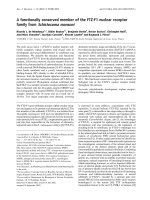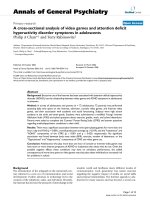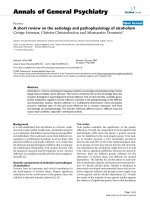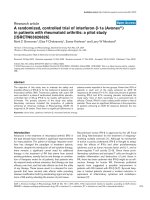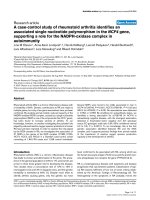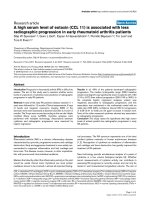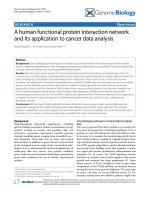Báo cáo y học: "A Canadian national survey of attitudes and knowledge regarding preventive vaccines." pptx
Bạn đang xem bản rút gọn của tài liệu. Xem và tải ngay bản đầy đủ của tài liệu tại đây (287.54 KB, 9 trang )
BioMed Central
Page 1 of 9
(page number not for citation purposes)
Journal of Immune Based Therapies
and Vaccines
Open Access
Original research
A Canadian national survey of attitudes and knowledge regarding
preventive vaccines
Paul Ritvo*
1,2,3,4,5
, Jane Irvine
1,2,3,6,7
, Neil Klar
2,4
, Kumanan Wilson
8
,
Laura Brown
5
, Karen E Bremner
9
, Aline Rinfret
10
, Robert Remis
2
and
Murray D Krahn
11,12
Address:
1
School of Kinesiology and Health Sciences, York University, Toronto, Canada,
2
Department of Public Health Sciences, University of
Toronto, Toronto, Canada,
3
Department of Psychiatry, University of Toronto, Toronto, Canada,
4
Division of Preventive Oncology, Cancer Care
Ontario, Toronto, Canada,
5
Division of Epidemiology, Biostatistics and Behavioural Science, Ontario Cancer Institute/University Health Network,
Toronto, Canada,
6
Department of Psychology, York University, Toronto, Canada,
7
Division of Behavioural Health Sciences, Toronto General
Research Institute/University Health Network, Toronto, Canada,
8
Department of Health Administration, University of Toronto, Toronto, Canada,
9
Department of Medicine, Toronto General Hospital/University Health Network, Toronto, Canada,
10
The Canadian Network for Vaccines and
Immunotherapeutics (CANVAC), CANVAC Coordinating Centre, Toronto, Canada,
11
Clinical Epidemiology, Faculty of Medicine, University of
Toronto, Toronto, Canada and
12
Clinical Epidemiology Health Policy Management and Evaluation, University Health Network and University of
Toronto, Toronto, Canada
Email: Paul Ritvo* - ; Jane Irvine - ; Neil Klar - ;
Kumanan Wilson - ; Laura Brown - ; Karen E Bremner - ;
Aline Rinfret - ; Robert Remis - ; Murray D Krahn -
* Corresponding author
preventive vaccinesattitudesknowledgenationwide Canadian survey
Abstract
Background: Vaccines have virtually eliminated many diseases, but public concerns about their
safety could undermine future public health initiatives.
Objective: To determine Canadians' attitudes and knowledge about vaccines, particularly in view
of increasing public concern about bioterrorism and the possible need for emergency
immunizations after weaponized anthrax incidents and the events of September 11, 2001.
Method: A 20-question survey based on well-researched dimensions of vaccine responsiveness
was telephone-administered to a random sample of N = 1330 adult Canadians in January, 2002.
Results: 1057 (79.5%) completed the survey. Respondents perceived vaccines to be highly
effective and demonstrated considerable support for further vaccine research. However, results
also indicate a lack of knowledge about vaccines and uncertainty regarding the safety.
Conclusions: Support for vaccines is broad but shallow. While Canadians hold generally positive
attitudes about vaccines, support could be undermined by widely publicized adverse events. Better
public education is required to maintain support for future public health initiatives.
Published: 05 November 2003
Journal of Immune Based Therapies and Vaccines 2003, 1:3
Received: 06 August 2003
Accepted: 05 November 2003
This article is available from: />© 2003 Ritvo et al; licensee BioMed Central Ltd. This is an Open Access article: verbatim copying and redistribution of this article are permitted in all
media for any purpose, provided this notice is preserved along with the article's original URL.
Journal of Immune Based Therapies and Vaccines 2003, 1 />Page 2 of 9
(page number not for citation purposes)
Background
Immunization against infectious disease has probably
saved more lives than any other public health interven-
tion, apart from the provision of clean water [1]. Vaccina-
tion programs are among the most effective public health
initiatives undertaken, credited with eliminating small
pox, virtually eliminating polio and substantially reduc-
ing the illness burden of infectious diseases such as diph-
theria, pertussis, and measles [1]. Vaccine technology has
recently been profiled in the international press with
emphasis on research aimed at new vaccines for Human
Immunodeficiency Virus (HIV) and cancer [2,3]. Terrorist
threats have also focused attention on anthrax and small-
pox vaccines as one means of public protection against
bioterrorism [4,5].
While vaccines have provided benefits, the effectiveness of
new and existing programs depends on the acceptance of
the public, which is increasingly challenged by concerns
about safety, particularly given possible findings linking
multiple sclerosis and the hepatitis B vaccine, and allega-
tions of linkage between autism and measles, mumps and
rubella vaccines [6,7]. While most public health officials
and epidemiologists believe these fears to be unfounded,
such fears undermine the effectiveness of vaccination pro-
grams. To provide an empirical basis for public education
efforts, we undertook a national survey to better under-
stand the public's acceptance of current and potential
future vaccinations and to explore their attitudes and lev-
els and types of knowledge.
Methods
Survey Instrument
The survey instrument consisted of 20 statements to
which subjects could respond "strongly agree", "agree",
"neither agree nor disagree", "disagree", "strongly disa-
gree", and "don't know enough to comment". Item selec-
tion was based on review of past surveys of attitudes and
knowledge in relation to vaccines [8–23], current infor-
mational materials for the Canadian public [24,25] and
expert review of item alternatives. The review panel con-
sisted of 2 health psychologists, 2 internal medicine spe-
cialists, 4 research immunologists, 1 public health
oriented epidemiologist, 1 survey research expert and 2
nurses. Instrument content was primarily devoted to 8
domains that figured prominently in past surveys and
informational materials. These domains were: vaccine
safety [8–21]; vaccine efficacy [8–21]; vaccine knowledge
[8–21]; vaccine acceptability [8–23]; anxiety about vac-
cines [8,10–21]; and opposition to vaccines [8,20,23]. In
addition we focused on attitudes towards vaccine research
and perceived religious barriers to use of vaccination. One
indication of the centrality of the dimensions focused on
in this study, particularly in the Canadian context, is that
vaccine safety, efficacy and knowledge are the first topics
addressed in the current Canadian Immunization Guide
[24] and in Your Child's Best Shot – A Parent's Guide to
Vaccination [25] (Canadian Pediatric Society), arguably
two central sources of vaccine information and promo-
tion in Canada. In addition to the centrality of these
dimensions in prior vaccine research, our rationale was
that if education and promotion efforts are focused in
these areas, it is important to derive nationwide Canadian
data about these dimensions of vaccine response.
Population sampling
The survey was carried out between January 4 and Febru-
ary 4, 2002 on a randomized sample of 1330 Canadian
adults, aged 18 years and older. There were separate rand-
omizations for the 3 largest cities, Montreal, Toronto, and
Vancouver, with percent population per province and per
city representative of Statistics Canada regionalized gen-
der data (of the population > or = to 18 years in 2000–
2001). The sampling process was performed by Canada
Survey Sample (CSS), a selection engine that generates
random samples of residential telephone numbers. The
CSS maintains a comprehensive list of all populated
exchanges across Canada, and is updated regularly. The
CSS randomly generated 4-digit suffixes for these
exchanges, in proportion to the percent population of the
individual exchanges. As each suffix was generated, it was
compared to the database of existing, known phone num-
bers. If it matched a listed phone number, it was placed in
the 'valid number' file. If it did not, it was placed in the
'orphan' file. The valid number file was used as the pri-
mary calling list and was supplemented with numbers
from the orphan list. As was true for the randomized pro-
cedure described above, numbers were chosen from the
orphan list in proportion to the percent population of the
exchanges. Since a significant number of "not-in-service"
numbers were encountered, a slightly higher than normal
ratio of respondents were sampled to ensure timely and
efficient survey fieldwork [26].
Statistical Methods
The data were initially weighted by region and gender
because the near-perfect regional and gender representa-
tion achieved by interviewing alone was disturbed by the
process of refusal conversions, which were undertaken to
achieve a high response rate. In this survey, the demo-
graphic characteristics of the sample and the responders
so closely approximated the true population that use of
weights did not alter results and, accordingly, weights
were not employed in analyses.
Descriptive statistics (frequencies, means, standard devia-
tions) were calculated to characterize the respondents and
their survey responses. As 18 years was the minimum age
for inclusion, the 6 respondents who gave 1984 as their
year of birth were presumed to be 18 by February 4, 2002.
Journal of Immune Based Therapies and Vaccines 2003, 1 />Page 3 of 9
(page number not for citation purposes)
Categories of age were constructed, based on quartiles of
the distribution, for categorical analyses. Relationships
between variables were evaluated by employing chi-
square, correlational, ANOVA, MANOVA and forwards
stepwise logistic regression analyses using SPSS for Win-
dows [27].
Results
Of the individuals contacted by telephone, 79.5% agreed
to complete the survey (N = 1057). Demographic charac-
teristics of the 1057 respondents are shown in Table 1.
Year of birth was not provided by 30 respondents. The
mean age of respondents was 44.78 years, with females (n
= 513) slightly older (mean ± SD age = 45.9 ± 16.8 years)
than males (n = 514, 43.72 ± 15.56, p < 0.05). More males
(n = 321) were employed full-time than females (n =
213), while more females (n = 236) than males (n = 157)
were unemployed (p < 0.001). Unemployed respondents
were older (53.64 ± 16.2 years) than those working full-
time (40.2 ± 10.15) or part-time (36.08 ± 14.91, p <
0.001).
Responses to Survey Items
Responses are shown in Table 2. In general, the responses
of subjects reflected positive attitudes. However,
Table 1: Demographic Data (N = 1057 respondents)
N%
Gender Male 525 49.7
Female 532 50.3
Age (Mean (SD)) (n = 1027) 44.78 (16.20)
Marital status Single (never married) 294 27.8
Married or common-law 620 58.7
Widowed 52 4.9
Separated 25 2.4
Divorced 49 4.6
Refused 17 1.6
Children Yes 721 68.2
No 327 30.9
Refused 9 0.9
Residence Urban 698 66.0
Rural 338 32.0
Refused 21 2.0
Province/City Newfoundland 21 2.0
Nova Scotia 37 3.5
Prince Edward Island 4 0.4
New Brunswick 31 2.9
Quebec (excl. Montreal) 137 13.0
Ontario (excl. Toronto) 233 22.0
Manitoba 42 4.0
Saskatchewan 39 3.7
Alberta 101 9.6
B.C. (excl. Vancouver) 77 7.3
Montreal 115 10.9
Toronto 157 14.9
Vancouver 63 6.0
Highest Education Less than high school 157 14.9
High school completed 307 29.0
Some college/university 132 12.5
College diploma 186 17.6
University undergraduate degree 200 18.9
University Masters degree 51 4.8
University Doctorate degree 9 0.9
Refused 15 1.4
Employment Full-time 534 50.5
Part-time 122 11.5
Not presently employed 393 37.2
Refused 8 0.8
Journal of Immune Based Therapies and Vaccines 2003, 1 />Page 4 of 9
(page number not for citation purposes)
Table 2: Responses (%) to Survey (N = 1057)
Strongly
agree
Agree Neither
agree nor
disagree
Disagree Strongly
disagree
Don't know
enough to
comment
Refused
Q1: The vaccines available are very carefully
and consistently tested for safety
16.8 50.3 4.5 4.4 0.9 22.9 0
Q2: The safeguards used in making vaccines
are slack and ineffective
2.67.94.833.510.640.4 0.2
Q3: Vaccines are amongst the most effective
and least costly forms ofmedical treatment
ever created
17.2 41.5 4.5 8.6 1.1 26.6 0.4
Q4: I don't really know what a vaccine is and
how it works
2.6 19.4 3.2 43.8 23.8 6.9 0.2
Q5: A vaccine is a medical treatment in
which dangerous viruses and bacteria are
killed or modified and then put into your
body
12.6 45.3 3.4 9.7 2.2 26.6 0.2
Q6: The reason vaccines are given regularly
to children is that they result in lifelong
protection from several serious diseases
34.9 48.9 3.3 5.3 1.2 6.3 0
Q7: A vaccine can give you a serious case of
the very same disease you're trying to avoid
4.9 24.7 7.4 31.0 8.6 23.2 0.2
Q8: The government should invest more
money in the development of vaccines for
serious diseases like AIDS, Hepatitis, and
Cancer
46.8 40.0 2.6 4.5 1.0 4.8 0.2
Q9: The idea of taking a newly developed
vaccine, even if it has been carefully safety
tested, makes me very anxious
8.8 33.8 8.2 30.7 8.8 9.5 0.3
Q10: Vaccines have, over the years,
produced many more health benefits than
health troubles
33.6 45.8 3.4 4.4 0.6 12.3 0
Q11: An increasing number of people are
becoming anti-vaccine oriented as more
information about vaccines and how they
are developed is available over the Internet
5.7 27.1 8.8 16.0 2.8 39.3 0.4
Q12: Those people who take anti-vaccine
positions are highly prejudiced and ill-
informed, scientifically
10.2 28.3 7.7 21.9 6.0 25.4 0.7
Q13: In view of the international situation
and the risks of bioterrorism, I would
readily take an anthrax vaccine
20.2 45.2 4.5 15.8 2.9 10.9 0.5
Q14: In view of the international situation
and the risks of bioterrorism, I would
readily take a smallpox vaccine
15.5 35.1 7.4 21.3 6.1 14.2 0.4
Q15: In view of the international situation
and the risks of bioterrorism, I would
readily take whatever vaccine was
promoted by the national government and
its medical advisors
15.2 40.6 9.6 20.5 4.5 9.2 0.4
Q16: I intend to take an influenza vaccine
this year, or I have already done so
21.3 24.3 4.3 34.2 11.4 4.0 0.6
Q17: If it were available, I would readily take
a vaccine to prevent HIV-AIDS
31.6 5.6 5.2 15.6 4.8 6.6 0.6
Q18: If it were available, I would readily take
a vaccine to prevent Hepatitis C
26.2 46.4 5.5 9.2 1.9 10.6 0.3
Q19: I have religious beliefs that prevent me
from taking vaccines
0.6 2.1 2.5 54.4 46.5 2.5 0.6
Q20: I don't really know why I received
vaccines as a child
5.2 18.4 2.1 41.5 25.3 6.4 1.0
Journal of Immune Based Therapies and Vaccines 2003, 1 />Page 5 of 9
(page number not for citation purposes)
significant proportions demonstrated negative attitudes,
insufficient knowledge and uncertainty.
Vaccine Safety
On the question, 'The safeguards used in making vaccines are
slack and ineffective', 40.4% indicated insufficient knowl-
edge, 4.8% indicated uncertainty, while 10.5% agreed
with the negatively worded statement. A positively
worded question, 'The vaccines available are very carefully
and consistently tested for safety', yielded similar results as
22.9% indicated insufficient knowledge, 4.5% indicated
uncertainty while 5.3% indicated negative attitudes to the
question.
Vaccine Knowledge
The most direct assessment of insufficient knowledge was
evident in responses to two items – 'I don't really know what
a vaccine is and how it works' and 'I don't really know why I
received vaccines as a child'. Nearly one-third of respond-
ents (32.1%) endorsed these items in ways indicating
insufficient knowledge, uncertainty, or an inability to
comment.
Vaccine Acceptability
The idea of taking new vaccines seemed to provoke anxi-
ety as indicated by responses to the item, 'The idea of taking
a newly developed vaccine, even if it has been carefully safety
tested, makes me very
anxious'. In all 42.6% of subjects
'agreed' (33.8%) or 'strongly agreed' (8.8%) with this
item. When the acceptability of specific vaccines was sur-
veyed the most acceptable potential vaccine was hepatitis
C with 72.6% of respondents affirming acceptability. A
potential HIV-AIDS vaccine was nearly as acceptable, with
67.2% affirming acceptability. Less acceptable were vac-
cines associated with potential bio-terrorist threats as only
50.6% indicated an anthrax vaccine was acceptable while
65.4% indicated a small pox vaccine was acceptable. It
was also evident that government endorsement of terror-
ist – protective vaccines was not a definitive influence in
promoting acceptability as only 55.8% of respondents
would take 'whatever vaccine was promoted by the national
government and its medical advisors'.
Vaccine Efficacy
In terms of general views of vaccine efficacy, subjects were
highly supportive with 79.4% endorsing either 'agree'
(45.8%) or 'strongly agree' (33.6%) to the item 'Vaccines
have, over the years, produced many more health benefits than
health troubles' while 58.7% endorsed either 'agree'
(41.5%) or 'strongly agree' (17.2%) to the item 'Vaccines
are amongst the most effective and least costly forms of medical
treatment ever created'.
Opposition to Vaccines
Over one-third of subjects indicated awareness of organ-
ized opposition to vaccination programs with 37.2 %
endorsing either 'agree' (27.1%) or 'strongly agree' (5.7%)
to the item 'An increasing number of people are becoming
anti-vaccine oriented as more information about vaccines and
how they are developed is available over the internet'. A major-
ity of subjects (61.7%) were reluctant to dismiss anti-vac-
cine positions, evidenced in their response to the item,
'People who take anti-vaccine positions are highly prejudiced
and ill-informed, scientifically' (27.9% – disagree or strongly
disagree, 25.4% – don't know enough to comment, 7.7%
– neither agree nor disagree).
Vaccine Research
The value of vaccine research was strongly supported, with
86.8% positively endorsing the item, 'The government
should invest more money in the development of vaccines for
serious diseases like AIDS, Hepatitis, and Cancer' (strongly
agree – 46.8%, agree – 40.0%).
Religious Barriers
There was little evidence that religious beliefs presented a
barrier to vaccination. Only 2.7% of respondents
endorsed the item, 'I have religious beliefs that prevent me
from taking vaccines'.
Associations of Responses
Vaccine Acceptability
Of the 28 people who said that religious reasons pre-
vented them from taking vaccines, 9 (32%) agreed to take
all 6 vaccines described, 7 (25%) agreed to take 5 and only
4 (14.3%) agreed to take none. Of the demographic vari-
ables, only employment status was related to willingness
to take vaccines. Respondents who were not presently
employed agreed to take 3.75 (±1.86) of the vaccines but
those working full-time agreed to take 3.4 (+1.9) (p <
0.05).
Overall Attitudes
We categorized responses to each question as "positive",
"negative", or "don't know/undecided", with "positive"
indicating vaccine acceptance, "negative' indicating vac-
cine opposition and "don't know/undecided" indicating
neither agreement nor disagreement, or insufficient
knowledge to comment. We calculated the number of sur-
vey questions for which each subject responded "posi-
tive", "negative", and "undecided/don't know", as a
summary measure of attitudes towards and knowledge of
vaccines. Table 3 shows the effects of demographics on the
number of vaccine-positive, vaccine-negative, and don't
know/undecided responses. Females were less knowl-
edgeable and more frequently undecided than males and
there was a significant linear trend towards more vaccine-
positive, fewer vaccine-negative and fewer don't know/
Journal of Immune Based Therapies and Vaccines 2003, 1 />Page 6 of 9
(page number not for citation purposes)
undecided responses, with increasing education. There
were no significant differences in any of the other demo-
graphic variables.
Lack of Knowledge
Among all respondents, 'don't know enough to comment'
was endorsed on an average of 3 (3.08) of the 20 survey
questions (SD= 2.72, range = 0 to 16), on average.
Gender, employment status and education were signifi-
cantly associated with the number of "don't know
enough" responses, as assessed through a MANOVA.
Females responded that they did not know enough to
comment on more questions (3.30 ± 2.73) than males
(2.86 ± 2.68 (p < 0.01). Higher education was associated
with fewer "don't know enough" responses (p < 0.001)
with the mean number of "don't know enough" responses
3.75 (±3.03), 2.88 (±2.38), 2.53 (±2.02), and 2.10
(±3.84) for those with less than high school, some college
or university, university undergraduate, and university
Masters degrees, respectively. Those not presently
employed responded "don't know enough" on 3.42
(±2.88) questions, compared with 2.79 (±2.57) by those
employed full-time (p < 0.01). Region of the country,
urban vs. rural residence, and age were not significant fac-
tors for number of "don't know enough" responses.
Variables Predicting Acceptability
In progressing towards a model of factors associated with
increased vaccine acceptability, we conducted a series of
analyses using the self reports of vaccine acceptability as
the outcome measure, and attitudes/knowledge items,
collapsed and summed into subscales, as predictor varia-
bles. Figure 1 shows the items that were grouped into the
subscales used to reflect predictor variables.
Table 3: Vaccine-Positive, Vaccine-Negative, and Don't Know/Undecided Responses Related to Demographic Characteristics
# Positive responses # Negative responses # Don't know/undecided responses
N Mean (S.D.) Mean (S.D.) Mean (S.D.)
Gender
Male 525 12.19 (3.84) 3.88 (2.80) 3.85 (3.01)
Female 532 11.77 (3.75) 3.80 (2.60) 4.37 (2.93)**
Marital Status
Single (never married) 294 11.85 (3.85) 3.91 (2.86) 4.18 (2.96)
Married / common-law 620 12.06 (3.75) 3.89 (2.70) 3.98 (2.88)
Widowed 52 11.23 (4.15) 3.61 (2.33) 5.09 (3.83)
Separated 25 12.96 (3.41) 2.84 (1.79) 4.16 (2.79)
Divorced 49 12.57 (3.26) 3.43 (2.27) 3.96 (3.02)
Children
Yes 721 12.10 (3.74) 3.84 (2.66) 4.00 (2.94)
No 327 11.77 (3.85) 3.88 (2.80) 4.29 (2.98)
Age Quartile (years)
18–32 256 12.01 (3.55) 3.64 (2.57) 4.33 (2.90)
33–42 252 11.80 (3.90) 4.00 (2.83) 4.17 (2.92)
43–55 263 12.18 (3.71) 4.01 (2.74) 3.74 (2.93)
56–88 256 12.20 (3.90) 3.62 (2.62) 4.08 (3.08)
Education
Less than high school 157 11.41 (3.41) 4.19 (2.56) 4.34 (3.23)
High school completed 307 11.64 (3.77) 3.81 (2.45) 4.47 (3.04)
Some college/ university 132 12.24 (3.39) 3.79 (2.71) 3.87 (2.50)
College diploma 186 11.75 (4.08) 4.23 (3.05) 4.01 (2.89)
University undergraduate degree 200 12.75 (4.00) 3.34 (2.78) 3.89 (3.05)
University Masters degree 51 12.96 (3.41) 3.63 (2.73) 3.33 (2.41)
University Doctorate degree 9 14.55 (4.36) ** 2.44 (2.24) * 3.00 (3.84) *
Employment
Full-time 534 12.06 (3.85) 3.85 (2.72) 4.04 (3.01)
Part-time 122 11.98 (3.50) 3.74 (2.75) 4.20 (2.67)
Not presently employed 393 11.92 (3.79) 3.85 (2.67) 4.16 (3.04)
Residence
Urban 698 12.03 (3.85) 3.78 (2.81) 4.13 (2.98)
Rural 338 11.94 (3.68) 3.95 (2.49) 4.05 (2.95)
* p < 0.05 between groups in ANOVA (with linear trend where applicable) ** p < 0.01 between groups in ANOVA (with linear trend where
applicable)
Journal of Immune Based Therapies and Vaccines 2003, 1 />Page 7 of 9
(page number not for citation purposes)
Survey Items – Grouped into Subscales Reflecting Five FactorsFigure 1
Survey Items – Grouped into Subscales Reflecting Five Factors
Table 4: Results from Multiple Logistic Regression
Outcome Factor B (S.E.) P value Odds Ratio
HIV-AIDS N = 804 Effectiveness .476 (.128) .000 1.61
Safety .318 (.111) .004 1.37
Knowledge .276 (.089) .002 1.318
Anxiety 033 (.102) .745 0.97
Not in Opposition .166 (.121) .172 1.18
HEP C N = 776 Effectiveness .603 (.143) .000 1.83
Safety .470 (.128) .000 1.60
Knowledge .273 (.106) .010 1.31
Anxiety .116 (.124) .349 1.12
Not in Opposition .251 (.144) .080 1.29
FLU N = 818 Effectiveness .250 (.114) .029 1.28
Safety .209 (.102) .039 1.23
Knowledge .215 (.074) .004 1.24
Anxiety .099 (.088) .256 1.10
Not in Opposition .040 (.107) .707 1.04
Safety
The vaccines available are very carefully and consistently tested for safety
The safeguards used in making vaccines are slack and ineffective
Effectiveness
Vaccines are amongst the most effective and least costly forms of medical treatment ever created
The reason vaccines are given regularly to children is that they result in lifelong protection from several
serious diseases
Vaccines have, over the years, produced many more health benefits than health troubles
Knowledge
I don't really know what a vaccine is and how it works
I don't really know why I received vaccines as a child
Anxiety
The idea of taking a newly developed vaccine, even if it has been carefully safety tested, makes me very
anxious
A vaccine is a medical treatment in which dangerous viruses and bacteria are killed or modified and then
put into your body
A vaccine can give you a serious case of the very same disease you're trying to avoid
Not in Opposition
(-) An increasing number of people are becoming anti-vaccine oriented as more information about
vaccines and how they are developed is available over the Internet
(+) Those people who take anti-vaccine positions are highly prejudiced and ill-informed, scientifically
Journal of Immune Based Therapies and Vaccines 2003, 1 />Page 8 of 9
(page number not for citation purposes)
Employing multiple logistic regression analyses we
derived three factor models in all, one to predict the self
reported acceptance of flu vaccine (in the past year) and
two additional models to predict the projected acceptance
of vaccines for HIV-AIDS and Hepatitis C, when and if
they become available. We derived the best 'fitting'
models and in each case found the significant predictor
variables were either perceived vaccine safety, vaccine
effectiveness or vaccine knowledge, although the most sig-
nificant predictors varied according to the specific vaccine.
As can be seen in Table 4 the results are fairly consistent
across vaccines as observable when scanning the varying
Odds Ratios and Significance Levels.
Discussion
The objective of this survey was to obtain a baseline meas-
ure of several key domains of attitudes and knowledge
concerning vaccines in a population-based sample. Due
to an absence of similar studies and the lack of compara-
tive results, it is difficult to ascertain how representative
our findings are and how modifiable or volatile attitudes
might be over time. It is also not yet possible to assess the
validity of results in predicting real behaviours, such as
immunization refusal, because data on refusals is not cur-
rently readily available.
While most Canadians can be characterized as having pos-
itive opinions about vaccine effectiveness and research,
there are some survey indications that might signal cau-
tion. On the question, 'The safeguards used in making vac-
cines are slack and ineffective', 40.4% of respondents
indicated insufficient knowledge, 4.8% indicated uncer-
tainty, while 10.5% agreed with the negatively worded
statement. A positively worded question, 'The vaccines
available are very carefully and consistently tested for safety',
yielded somewhat similar results as 22.9% indicated
insufficient knowledge, 4.5% indicated uncertainty while
5.3% indicated negative attitudes to the question. While it
is debatable how much lay citizens might be expected to
know, content-wise, about the safeguards implemented in
producing vaccines, there is little question that positive
indications of knowledge are desirable. The 40.4%
response of insufficient knowledge may therefore be seen
as one indication of where future education efforts might
be directed.
In the context of this study, it would appear the attitudes
subjects hold about vaccine safety and efficacy, and their
self-perceived knowledge, generally, are associated with
willingness to take either hypothetical vaccines currently
in development (e.g. Hepatitis C, HIV-AIDS) or vaccines
currently existing (Flu, Small Pox, Anthrax).
Most would be willing to take anthrax and smallpox vac-
cines, in view of the risks of bioterrorism. However, only
50% said they were actually taking the available influenza
vaccine. Agreement to take vaccines that were currently
unavailable on a widespread basis was higher – perhaps
because these were for serious diseases, or because it is
easier to endorse the acceptance of a vaccine that does not
yet exist.
The result of this survey that might be an indication for
most concern is the lack of knowledge about vaccines dis-
closed by Canadians. As many as 45% of respondents did
not know enough to comment definitively about the
safety of vaccines. Virtually, all substantive theories of
behaviour change emphasize knowledge as a necessary
factor in adoptive behaviour. Our results thus indicate a
need for educational interventions, particularly given the
real risks of bioterrorism. If we had to immunize on an
emergency basis, either locally or regionally, a stronger
base of public knowledge would be a valuable and per-
haps highly important asset.
Although our survey indicated that 79.4% of subjects held
positive views of vaccine efficacy, a majority of subjects
(61.7%) were reluctant to dismiss anti-vaccine positions.
This may reflect the public's potential for persuasion by
pro- and anti-vaccine literature and argument. Perhaps
because vaccine technology can appear counter-intuitive,
i.e. a weakened pathogen or foreign protein is deliberately
inserted in the body, it is an act of social trust to take a vac-
cine. One must trust the scientific discoveries underlying
the vaccine and the production methods of the specific
vaccination one receives. Furthermore, one must accept
the 'tough love' of herd immunity – that the irreducible
risks of vaccines mean some individuals experience the
detriment of negative side effects (including fatality) for
the beneficial protection of the great majority. In past
studies that surveyed vaccinators and non-vaccinators
[10], perceived dangerousness, doubts about efficacy,
unwillingness to accept vaccine-mortality, beliefs that
physicians overestimate disease risk and perceived disease
susceptibility were the most significant factors predicting
non-vaccination. Although the study, referred to above,
used a highly selective sample, disproportionately
selected from higher SES strata, it provided some
validation of factors associated with vaccine refusal. The
significant associations between our attitudinal and
acceptability items can be interpreted as providing sup-
port for at least two (dangerousness and efficacy) of the
predictive factors indicated in this other investigation.
In summary, our results indicate that despite a surprising
lack of knowledge about vaccines, most Canadians are
prepared to accept new vaccinations. Educational efforts
on the part of public health officials may improve public
receptivity. On the other hand, the lack of knowledge of
vaccines may make Canadians susceptible to messages
Publish with BioMed Central and every
scientist can read your work free of charge
"BioMed Central will be the most significant development for
disseminating the results of biomedical research in our lifetime."
Sir Paul Nurse, Cancer Research UK
Your research papers will be:
available free of charge to the entire biomedical community
peer reviewed and published immediately upon acceptance
cited in PubMed and archived on PubMed Central
yours — you keep the copyright
Submit your manuscript here:
/>BioMedcentral
Journal of Immune Based Therapies and Vaccines 2003, 1 />Page 9 of 9
(page number not for citation purposes)
from anti-vaccination groups. An example of the potential
impact of these groups can be seen in the UK where fears
over Measles-Mumps-Rubella-induced autism have
resulted in significant reductions in MMR coverage and
consequent outbreaks of measles [28]. If these impacts
can occur under normal conditions and vaccination
schedules, we may be more susceptible under conditions
of heightened anxiety and emergency immunization.
Authors' contributions
PR, JI, NK, KW, LB, AR, RR, and MK participated in survey
construction. AR performed survey translation. PR, JI, NK,
KB, and MK completed data analysis. All authors partici-
pated in rough and final drafting.
References
1. Plotkin SL and Plotkin SA: A short history of vaccination. In Vac-
cines Edited by: Plotkin SA, Orenstein WA. Philadelphia: Saunders;
1999:1-11.
2. Makgoba MW, Solomon N and Tucker TJ: The search for an HIV
vaccine. BMJ 2002, 324:211-213.
3. de Gruijl TD and Curiel DT: Cancer vaccine strategies get big-
ger and better. Nature Medicine 1999, 5:1124-1125.
4. Henderson DA, Inglesby TV, Bartlett JG, Ascher MS, Eitzen E, Jahrling
PB, Hauer J, Layton M, McDade J, Osterholm MT, O'Toole T, Parker
G, Perl T, Russell PK and Tonat K: Smallpox as a biological
weapon: medical and public health management. Working
Group on Civilian Biodefense. JAMA 1999, 281:2127-2137.
5. Swartz MN: Recognition and management of anthrax. NEJM
2001, 345:1621-1626.
6. Marshall E: A shadow falls on hepatitis B vaccination effort. Sci-
ence 1998, 281:630-631.
7. Wakefield AJ, Murch SH, Anthony A, Linnell J, Casson DM, Malik M,
Berelowitz M, Dhillon AP, Thomson MA, Harvey P, Valentine A, Dav-
ies SE and Walker-Smith JA: Ileal-lymphoid-nodular hyperplasia,
non-specific colitis, and pervasive developmental disorder in
children. Lancet 1998, 351:637-641.
8. Gellin BG, Maibach EW and Marcuse EK: Do parents understand
immunizations? A national telephone survey. Pediatrics 2000,
106:1097-1102.
9. Mieczkowski TA and Wilson SA: Adult pneumococcal vaccina-
tion: a review of physician and patient barriers. Vaccine
2002:1383-1392.
10. Liau A and Zimet GD: The acceptability of HIV immunization
examining characteristics as determining factors. AIDS Care
2001, 13:643-650.
11. Liau A and Zimet GD: Undergraduates' perceptions of HIV
immunization: attitudes and behaviors as determining
factors. International Journal of STD and AIDS 2000, 11:445-450.
12. Zimet GD, Blythe MJ and Fortenberry JD: Vaccine characteristics
and acceptability of HIV immunization among adolescents.
International Journal of STD and AIDS 2000, 11:143-149.
13. Honkanen PO, Keistinen T and Kivela SL: Factors associated with
influenza vaccination coverage among the elderly: role of
health care personnel. Public Health 1996, 110:163-168.
14. Zimet GD, Fortenberry JD and Blythe MJ: Adolescent's attitudes
about HIV immunization. Journal of Pediatric Psychology 1999,
24:67-75.
15. Webb PM, Zimet GD, Mays R and Fortenberry JD: HIV immuniza-
tion: acceptability and anticipated effects on sexual behavior
among adolescents. Journal of Adolescent Health 1999, 25:320-322.
16. Liau A, Zimet GD and Fortenberry JD: Attitudes about Human
Immunodeficiency Virus immunization. Sexually Transmitted
Diseases 1998, 25:76-81.
17. Nichol KL and Zimmerman R: Generalist and subspecialist phy-
sician's knowledge, attitudes and practices regarding influ-
enza and pneumococcal vaccinations for elderly and other
high-risk patients. Arch Intern Med 2001, 161:2702-2708.
18. Nichol KL, Lofgren RP and Gapinski J: Influenza vaccination. Arch
Intern Med 1992, 152:106-110.
19. McPhillips HA, Davis RL, Marcuse EK and Taylor JA: The rotavirus's
vaccine's withdrawal and physician's trust in vaccine safety
mechanisms. Arch Pediatr Adolesc Med 2001, 155:1051-1056.
20. Fiebach NH and Viscoli CM: Patient acceptance of influenza
vaccination. Am J Med 1991, 91:393-400.
21. Mezaros JR, Asch DA, Baron J, Hershey JC, Kunrether H and
Schwartz-Buzaglo J: Cognitive processes and the decisions of
some parents to forego pertussis vaccination for their
children. J Clin Epidemiol 1996, 49:697-703.
22. Epee-Bounya A, Gitterman BA and Moon RY: Parental opinions
regarding poliomyelitis immunizations. Clinical Pediatrics 2001,
40:435-440.
23. Lehrke P, Nuebling M, Hofmann F and Stoessel U: Attitudes of
homeopathic physicians towards vaccination. Vaccine 2001,
19:4859-4864.
24. National Advisory Committee on Immunization: Canadian Immuniza-
tion Guide 6th edition. Ottawa, Ontario: Health Canada; 2002.
25. Gold R: Your Child's Best Shot – A Parent's Guide to Vaccination Ottawa,
Ontario: Canadian Pediatric Society; 2002.
26. Lepkowski JM: Telephone sampling methods in the United
States. In Telephone Survey Methodology Edited by: Groves RM, Biemer
PP, Lyberg LE, Masset JY, Nicholls II WL, Waksberg J. New York John Wiley
and Sons; 1988:73-98.
27. SPSS for Windows Chicago: SPSS Inc; 2000.
28. Jackson T: Public less worried about MMR vaccine than many
other issues. BMJ 2002, 324:630.
